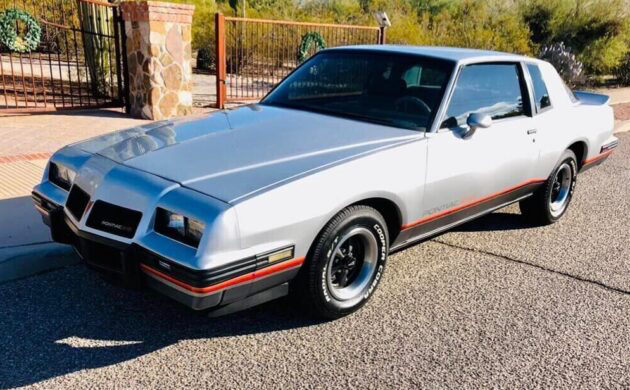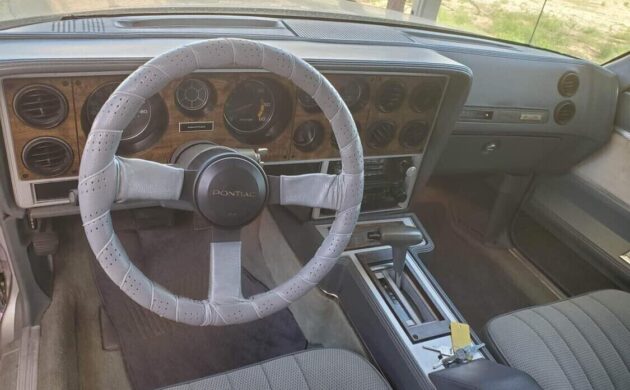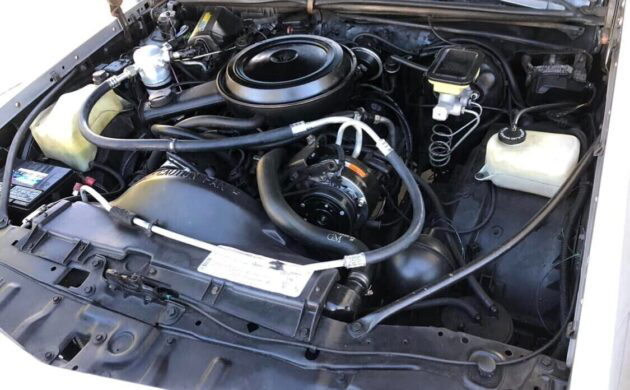There was a time when aerodynamic efficiency had no place in automotive design. Early attempts to tackle what many saw as a black art often received a negative buyer response. Even later attempts sometimes suffered the same fate, although it is now accepted as an industry norm. The 1986 Pontiac Grand Prix 2+2 leaned heavily on aerodynamics as a homologation special for NASCAR competition. It emerged in a single year in limited numbers, and tidy examples can generate interest in the classic market. This one is a tidy survivor with no pressing needs. It is listed here on eBay in Tucson, Arizona. Bidding has raced to $10,100 in a No Reserve auction.
Enzo Ferrari once famously said, “Aerodynamics are for people who can’t build engines.” He advocated for sheer horsepower to provide the winning edge, with his company producing some of the most potent engines in motorsport history. However, when a category is as tightly controlled as NASCAR, manufacturers will always seek what is often referred to as “the unfair advantage.” After the controversial models produced in 1969 and 1970, the category managers kept a tight rein in that area, but manufacturers continued to push the boundaries while not breaking the rules. The result was homologation models like the 1986 Pontiac Grand Prix 2+2 and its cousin, the Chevrolet Monte Carlo SS Aerocoupe. The reprofiled nose wasn’t radical, but you must view the car from this angle to see where the development money went. The sloping rear window gives the conventional Grand Prix an almost fastback appearance, allowing the air to flow undisturbed onto the rear spoiler mounted on the fiberglass trunk lid. It improved downforce and speed, especially on the superspeedways like Daytona and Talladega. It was also an appearance that polarized buyer opinion. Some appreciated it for what it represented, while some considered it unspeakably ugly. Regardless of which view you might favor, it is hard to criticize this Pontiac’s presentation. Its Silver paint shines nicely, with no patchiness or matte sections that can plague this shade. The stripes look crisp, and the plastic is in excellent order. There are no apparent rust issues, which is probably no surprise considering the vehicle’s location. The glass is flawless, including the vehicle-defining back window.
The Pontiac’s interior is tidy for a vehicle of this type and age, with visible modifications limited to a wheel wrap and an aftermarket radio/cassette player occupying the spot usually reserved for the factory unit. There are some dirty marks and slight stretching on some of the Gray cloth trim pieces, and while a deep clean may remove the marks, the wrinkling is acceptable for a driver-quality classic. The plastic is in good order, with no evidence of dash cracks. The carpet is marked below the driver’s feet, but that is another flaw that may respond to professional cleaning. Otherwise, there is little to criticize beyond the typical (and easily fixed) sagging headliner. Although the company produced the Grand Prix 2+2 as a racing special, they provided some welcome creature comforts. This one scores air conditioning, power windows, power locks, cruise control, and a tilt wheel.
Pontiac produced the 2+2 with a “one size fits all” philosophy. Ordering one brought the new owner a 305ci V8, a four-speed 200-4R automatic transmission, power steering, and power brakes. With 165hp on tap, the Grand Prix took 17 seconds to cover the ¼ mile. That figure was the industry norm for a vehicle of this type in 1986, but even the advanced aerodynamics couldn’t help the 2+2 achieve a top speed higher than any other Grand Prix derivative with a V8 under the hood. However, the efficient airflow across the rear spoiler made the 2+2 more stable than its brethren at those speeds, which was the object of the exercise. The seller says this classic runs and drives extremely well, with a strong V8 and a smooth transmission. This could be a strong contender for a buyer seeking a turnkey vehicle.
After the “winged warriors” that had dominated the category during 1969 and 1970, NASCAR became naturally twitchy whenever a manufacturer mentioned aerodynamics. Those cars saw speed and safety pushed beyond what was deemed acceptable, leading to their eventual banning. Manufacturers took a different approach in later years, and the 1986 Grand Prix 2+2 reflects that thinking. Only 1,118 examples emerged during the single production year, and after remaining largely forgotten like many cars from that era, they are gaining traction in the classic market. When a tidy example appears with No Reserve, it will invariably generate interest. This one has received seventeen bids, but I expect that number will climb before the auction ends. Is this a classic you would consider pursuing, or can’t you warm to its distinctive styling?












This is a very nice Grand Prix 2+2 with under 63,000 miles. I know the 305 is not fast but… Pull the 305 install a stroker 383/450hp nice dual exhaust. I wonder if the trans would last in it. Then it would be a fun weekend ride. Good luck to the next owner. 🐻🇺🇸
The trans.Nope especially if you drive like you stole it.Probably 2004r which was a decent trans just not made to be beat on in stock configuration with a lot of hp in front of it.
The 2004R is a good trans but needs beefing if you want to put more power to it. The gear ratios are far better a spread that the 700. Check out Art Carr and the outfit he sold his first company to. The performance units they produce are well worth it, and the fit perfectly in place of a TH350.
Not sure if stock trans would handle additional Tq..as well as converter.
As i gracefully grow old , my back pain is slowly vanishing and i am once again considering a manual shift car and i could not accept driving a nascar tribute with an auto trans unless its a steering shifted 8 speed ! A friend had one of these ,it was a slug but the looks are very distinctive and with a 2 inch suspension drop , they look cool …
I always loved the look of these, they should have dropped the GN Turbo 3.8 in these I’m sure it’s a direct fit and they would have sold tons of them.
GM wasn’t interested in selling “tons” of these (or the Monte Carlo Aerocoupe) because their sole reason for existing was to build just enough street cars to homologate the more aerodynamic fastback glass profile (and this GP 2+2 nose cone) for NASCAR.
Being a NASCAR-associated limited-production run, they knew they’d sell every single one of the few they were required to build regardless, even with a base V8.
That’s why they never bothered equipping these with a hotter engine or investing in engineering them to work as proper hatchbacks, and they probably lost money on each unit sold anyway, as they required considerable hand-building off the main assembly line to convert from standard (non-aero) bodyshells.
Especially since they put it in the Firebird
GM made these as a direct response to the 1984-87 Ford Thunderbirds, that were eating their lunch on the super speedways. It didn’t help. But, they were cool looking cars.
Sorry never cared for these but that’s just me. I’d hate to try and find a rear window for one of these if it ever broke. Glwts.If you like these it looks like very clean well kept example.
One of the few of these that were produced ended up being a confiscated vehicle by the police department I retired from. It was used as an undercover vehicle believe it or not, lastly by the internal affairs unit. I retired in 2005 and it was still being used.
Nice!
The 305 seems like a hot rod next to the Pontiac built 301 2 barrel they forced on base V8 model GP buyers in the late 1970s. I prefer the formal styling on the Grand Prix but it appears the rear headroom is not sacrificed..just the back glass is sharply angled. The styling of the 1969-77 bigger intermediates is superior but the shorter wheelbase is a blessing in disguise when parking, cornering and maeuvering in an urban environment. This is not a bad car at all if the bidding does not go too high.
This is one of those vehicles I’d have to “slightly” modify and drive…give it a roller 383 with a dual-snorkle intake but no other appearance add-ons. Add some 17 in Rally wheels (https://www.yearone.com/Product/wheels/prw178gun#prettyPhoto%5Bpart%5D/0/) along and a slight drop, this would be a killer cruiser to drive 1000 miles a year.
Yes, I like the styling.
Not sure if it’s lower than stock up front or higher in the rear.
With no cracks in the interior, why the steering wheel cover? – maybe just for protection?
Any of these sold in Mexico with a 350 motor & manual trans, like the Monte SS?
Were aluminum snowflake wheels optional/available on these cars?
Any of these or Monte SS’s come without A/C? I never seen one as such.
Padded steering wheel covers are pretty common even on new cars here in Tucson, where we like to joke you need oven mitts to drive in summertime.
The stock Gbody steering wheel is very small in diameter. The wrap is there to give you something to hold on to if you don’t want to change to a larger wheel.
JoeNYWF64, the Grand Prix 2+2 was and is a “what you see is what you get” piece. There were no options, and no variations of any kind were offered. It wasn’t even possible to special order one.
The Grand Prix 2+2 program was entirely different from the Monte Carlo Aerocoupe program. Chevrolet actually tried to sell the Aerocoupe as a distinct model that could be special ordered by the customer, and yes, was also reportedly offered for sale in the Mexican market. Pontiac, on the other hand, cranked out just enough identical copies of the 2+2 to homologate them for Nascar, put every one of them into the Product Evaluation Program (employee-driven cars, often referred to as “brass hats”), then sold them to dealers at a discount to get rid of them.
I like these G body GM cars, and had two, an 87 442 and an 86 Monte Carlo SS. Almost bought an 88 Cutlass Supreme Classic, but that deal fell through. These cars are nice to look at, but underpowered and made very cheaply. This car must have been babied very well to be in such good shape. I hope it finds a good home, someone who will appreciate it for what it is and preserve it.
What’s up with the mileage history on the Auto Check on Ebay? It doesn’t make any sense for a 63000 mile car
I have a ’74 Grand Prix, a true heavyweight!
Currently trying to get back to cruiser status and I’m very close. Complete rebuild on 6.6 ltr big BLK, less than 500 miles. Newly rebuilt 400r shift flawlessly! Have other add on details for performance. The down side would be interior aesthetics, but simple detail decisions! In Phx 6026872323
SOLD for $13,900. Seems like a decent buy to me.
I almost broke my neck doing a double take the other day when I saw a clapped out version of this driving around town. I haven’t seen one in years then WHAMO! there’s one that looks like it’s been parked under a tree with the windows down for the last 10 years.
Sad.